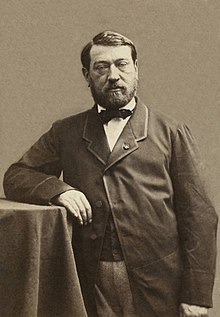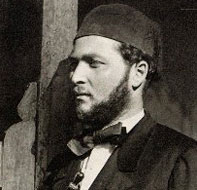Auguste Mariette
François Auguste Ferdinand Mariette, partly Auguste -Edouard Mariette ( born February 11, 1821 in Boulogne -sur -Mer, † January 18, 1881 in Bulak in Cairo ) was a French Egyptologist. He is the founder of the monuments in Egypt and the Egyptian Museum in Cairo.
Life and work
Auguste Mariette was initially a teacher in his native town in 1849 and received a job at the Egyptian Museum in Paris. In October 1850 he traveled on behalf of the Louvre to Egypt to buy Coptic, Syrian and Ethiopian manuscripts. The negotiations turned out to be tough, and Mariette passed the time with trips to historical sites. On one of these trips, he discovered at Saqqara a Sphinx and believed the Serapeum to have the underground burial place of the Apis bulls found. Without official permission, he started to dig and found in 1851 actually the entrance to the Sanctuary. It contained 24 large stone sarcophagi, hewn out of a single 80 -ton block of granite. Because the lid of this stone boxes are all pushed to the side and the sarcophagi were entirely empty, the researchers always held the view that they would have been systematically looted. In the following years, Mariette smuggled some 7,000 objects to France. After his return in 1854 he was appointed Second curator of the Egyptian Department of the Louvre.
1855 Mariette visited at the invitation of Alexander von Humboldt Berlin; here he met the Egyptologist Heinrich Brugsch, composer Franz Liszt, the painters Eduard Hildebrandt, Christian Gottfried Ehrenberg and Christian Daniel Rauch and the banker Alexander Mendelssohn.
But in 1857 he traveled a second time to Egypt to continue his excavations. He opened the graves here without regard to the findings with explosives. In 1858 he was appointed Director of the Antiquities Service of Viceroy Said Pasha and was henceforth entrusted with the ultimate direction of the initiated by the government excavations. In 1862 he was appointed Bey first class, and in 1879 he received the title of Pasha.
In this position, Mariette now put all our energy to ensure that the Regulation was respected for the protection of antiquities in Egypt. In 1859 he founded to keep the numerous finds the later Egyptian Museum in Cairo. He prevented the precious jewels of the grave treasure of Queen Ahhotep I., which were shown to the World Exhibition in Paris in 1867, as a "gift " for the French Empress Eugénie ended.
Under Mariette most important monuments were unearthed; his most important work of this kind is the exposure of the Temple of Abydos and Edfu. His last achievement was the opening of three pyramids of the 6th dynasty at Sakkara, which contain in their inner chambers grave important inscriptions.
Mariette died ten years after the premiere of Verdi's opera Aida in Cairo, with a libretto based on the novel, Mariette. In his native city, a monument to him was erected in 1882.
Publications
- Tome 1: Papyrus no 1 à 9 1870/1871;
- Tome 2: Papyrus no 10 à 20, 1872;
- Tome 3: Papyrus no 21 à 22, 1876.





,_%2525C3%2525A0_gauche,_%2525C3%2525A0_la_maison_d%2527Auguste_Mariette_au_Caire_(Bulaq)..jpg)



